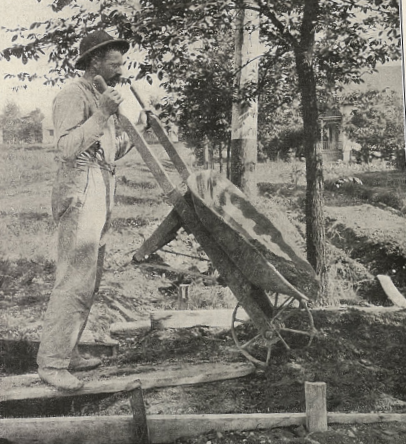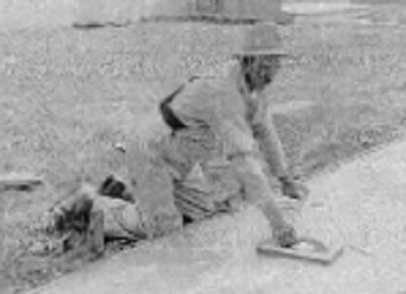Concrete on the Farm, 1900-1940: Part 5--Placing the Concrete
In the concluding Part 5 of this series, concrete historian Luke Snell describes how the farmer placed and finished the concrete and shows some examples of how the concrete was used.

Now that the concrete is mixed, the farmer has to get it in place and finished. The first task is to move the concrete from where it was mixed it to where it is to be placed. This would normally be done with a wheelbarrow balanced on a plank as shown in Picture 1.

1. Moving the concrete by wheelbarrow.
Once the concrete was in place, the farmer would need to consolidate it. In modern construction this would be done with a vibrator that get the entrapped air out of the concrete and make the concrete into a solid mass. Vibrators were unfortunately not available, so the farmer would use one of two methods (Picture 2). For a flat surface, such as a floor, they would use a tamping rod. This method basically beats the concrete into a flat surface and provides a very dense and durable concrete. When building a concrete wall, they would use a spade. By today’s standards the concrete was quite stiff and took a lot of effort to consolidate.

2.. Consolidating the concrete with a tamping rod.
Once the concrete was consolidated, the farmer would finish the concrete surface. In Picture 3, the farmer is using a wooden float. This left a slightly rough surface, which was ideal. If the surface was finished smooth, it would be slippery and provide little skid resistances. This slightly roughen surface was desirable especially for barn floors since they did not want a cow to slip and fall.

3. Finishing the concrete.
Below are pictures of projects that the self-help books of the early 20th Century suggested that the farmer was now able to accomplish. These include a building foundation, a clean area in front of a building, a clean area for livestock, a corn crib floor, tree repair, and concrete fence posts. These pictures only touch on some of the projects where the farmer could use concrete.
Hopefully this series of articles, Concrete on the Farm, have helped you realize how important concrete was to farmers in those days. While researching these articles, I developed an appreciation (and hopefully you did too as you read them) of the many skills these farmers had to master while running their farm.




About the Author(s)
You May Also Like




